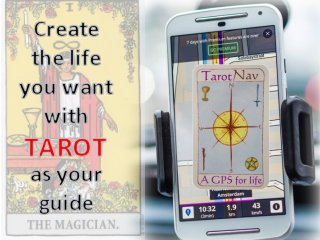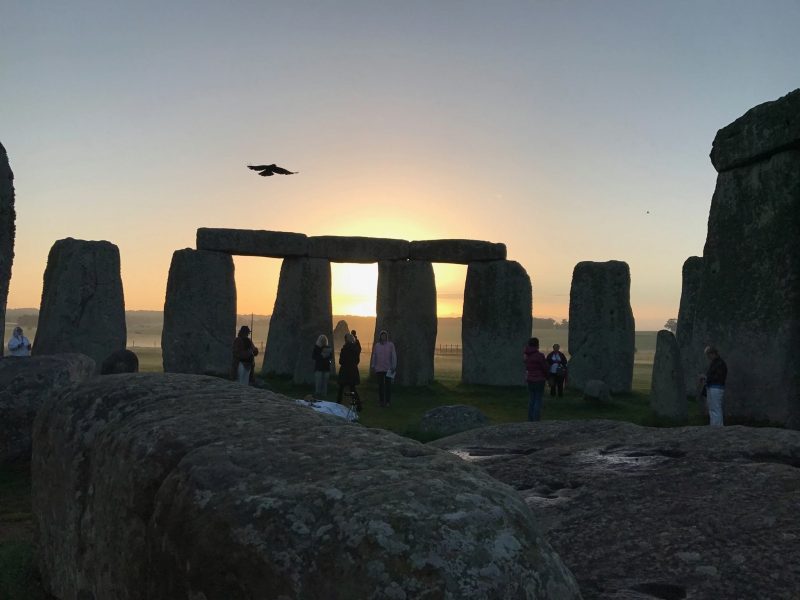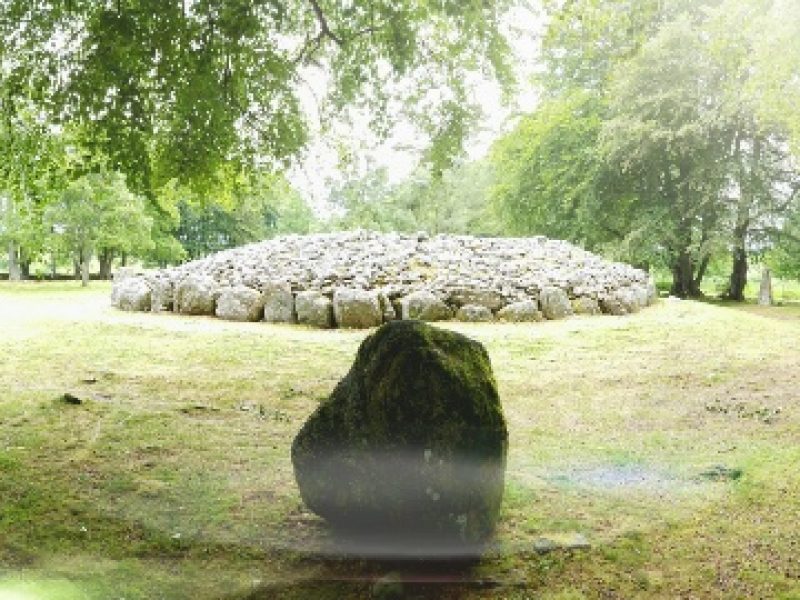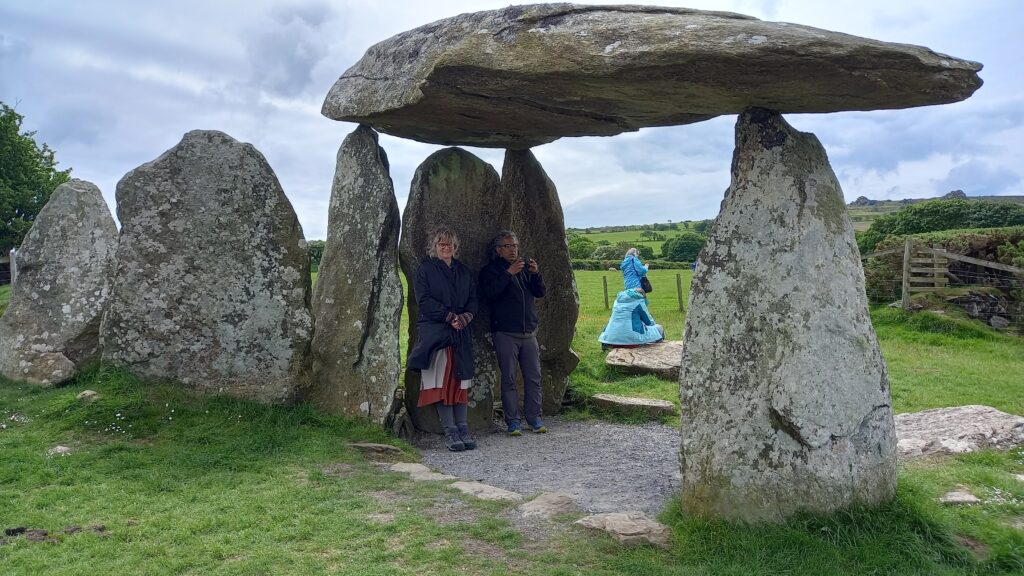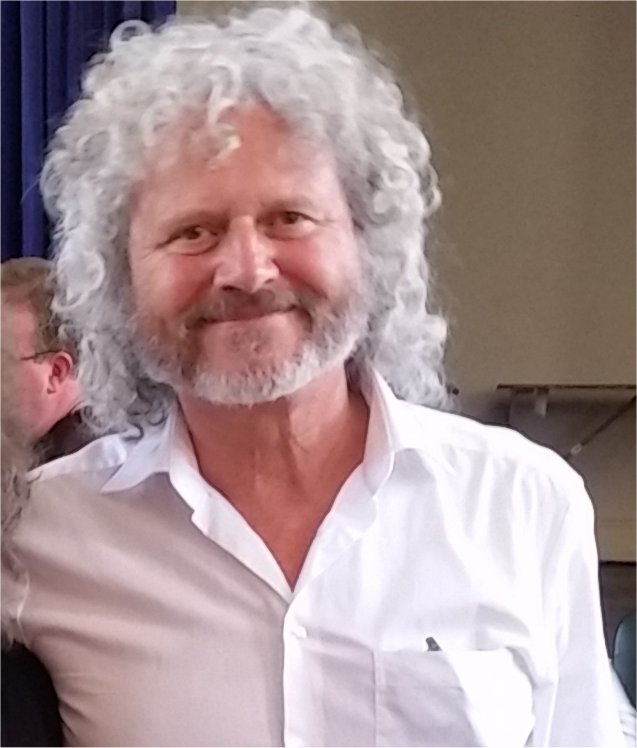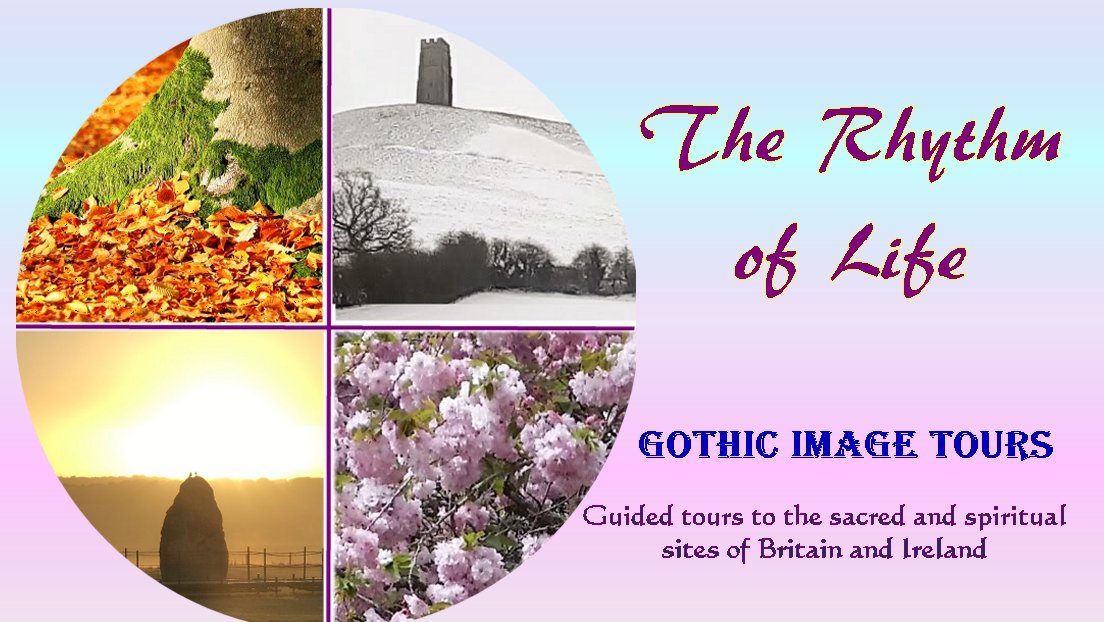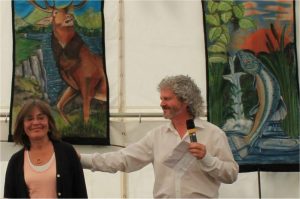
One of the most popular Tarot decks on the market is The DruidCraft Tarot, created by Philip and Stephanie Carr-Gomm along with artist Will Worthington. Why has a deck that brings Wicca, Druidry and Tarot together gained such a following in the decade since its publication? To explore possible reasons for this phenomenon I spoke with Philip Carr-Gomm who was the Chief of the Order of Bards, Ovates and Druids (OBOD) for more than 30 years.
I had the pleasure of taking part in celebrations for the 50th anniversary of the modern Druid Order last year in Glastonbury. Philip describes himself as ‘utterly non-clairvoyant’ when it comes to predicting the success of the deck and aspects of how the Order has developed since the late 1980s. One exception was a flash he had at his initiation into the Order at the age of 18 on Glastonbury Tor. The circle comprised a dozen or so elderly people and during the proceedings he had a brief flash of hundreds of people, dogs, banners and colours. That certainly came to pass. I stood with hundreds of fellow Druids on the Tor last year, Stephanie’s colourful banners were held aloft, the sounds of drumming and singing were everywhere and the ritual to mark the 50th anniversary was joyous and moving.
Philip and Stephanie have recorded two master classes for Global Spiritual Studies called The DruidCraft Tarot: a gateway to inner wisdom. They demonstrate their ‘Integrative Tarot Training’, method, a special way of learning how to use the Tarot to connect to our deep inner knowing, giving us insights normally inaccessible to our rational minds.
[spacer height=”20px”]LINDA: How does the trio of Druidry, Wicca and Tarot work together?
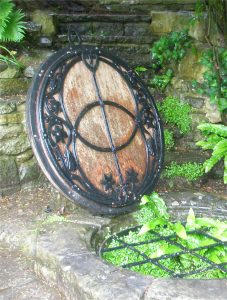 PHILIP: Druidry and Wicca are the two great pillars of Pagan tradition that developed in the British Isles. They have many similarities but also, some rather interesting differences which actually complement each other. The two overlapping circles of the Vesica Piscis on the well cover at Chalice Well is a wonderful symbol for their relationship. They are two unique separate systems, but they can also be combined. When you fuse them together, you get this fantastic area of meeting – that bit in the middle, the Piscis, which is incredibly powerful.
PHILIP: Druidry and Wicca are the two great pillars of Pagan tradition that developed in the British Isles. They have many similarities but also, some rather interesting differences which actually complement each other. The two overlapping circles of the Vesica Piscis on the well cover at Chalice Well is a wonderful symbol for their relationship. They are two unique separate systems, but they can also be combined. When you fuse them together, you get this fantastic area of meeting – that bit in the middle, the Piscis, which is incredibly powerful.
[spacer height=”20px”]When we started to look at the Tarot, we realised that its universal language of symbolism works very well with the ideas of Druid Craft – polarity, magic, the circle, the four directions, initiation and so on. The Tarot was a natural way of expressing the ideas of Druid Craft and the ideas of Druid Craft enhance our understanding of the Tarot. So, it’s a way into the Tarot as well as the Tarot offering a way into Druidry and Wicca.
LINDA: The Major Arcana of the Tarot tells the story of the universal human journey, what Joseph Campbell calls the hero’s journey. The story of Ceridwen and Taliesin plays a similar role in Druidry and much of the imagery in The DruidCraft Tarot is drawn from it. What are the main elements of the story?
PHILIP: It’s a story of initiation, coming of age, of a child becoming an adult. It’s also a story of transformation with elements of alchemy. We work with this story in the Bardic Grade of the Order in great depth, entering into and learning from it.
[spacer height=”20px”]The Goddess Ceridwen had two children, a girl who was beautiful and a boy who was ugly. She decided that if her son could not have good looks, then he could at least have wisdom. In the books of the mystical alchemists known as the Fferyllt, she found a recipe for gaining that wisdom in the form of an elixir which had to be prepared in a cauldron. She chose an old blind man and a boy, Gwion, to tend the fire beneath the cauldron. But just as the elixir was ready, its vital first three drops of inspiration (Arwen) were tasted accidentally not by her ugly son, but by Gwion. Ceridwen chases after him and during the chase they both shape-shift into different creatures until the final transformation when Gwion becomes a grain of wheat, only to be consumed by Ceridwen as a hen.
Nine months later Ceridwen gives birth to a baby boy. She places him in a leather bag and sets him adrift on the ocean. The bag is found by Elphin, who becomes his foster father. He calls him Taliesin and Taliesin becomes the finest Bard in the land.
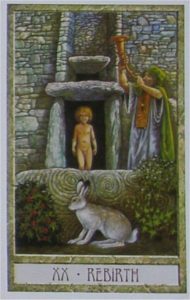 LINDA: Can you give us an example of how you’ve put the imagery of the story into the cards?
LINDA: Can you give us an example of how you’ve put the imagery of the story into the cards?
PHILIP: Let’s look at Rebirth, the Judgement card in traditional decks. In the story, Gwion ends up as Taliesin, this young boy who’s born of the womb of the Goddess. On the traditional Judgement card an angel blows a horn on the last Day of Judgment and people rise from their coffins. Now, unless you’re a Christian, you probably won’t find that an attractive image!
The image we created was that of a little boy appearing out of New Grange in Ireland which is oriented to the winter solstice, when the sun is reborn at dawn. The initiate, Taliesin, comes out of the long chamber in New Grange that directs the dawn ray directly into its centre. He is born and a priest blows a dord, a Bronze Age trumpet. Other symbols of rebirth are the triple spiral and the hare. So, we’ve got it all. We kept the traditional Tarot symbolism but not the Christian imagery. We have pre-Christian, DruidCraft, pagan imagery instead.
LINDA: Another card that is quite different to the traditional Rider Waite image is the Three of Swords. The DruidCraft Tarot card is dramatic in a different way.
 PHILIP: This is another example of changing Christian imagery. If you’ve ever been into churches in Spain, you’ll know there are statues with pierced hearts, dripping lots of blood and flowing tears…the Rider Waite image. Again we asked ourselves ‘How can we convey the same basic ideas, but in a different way that gets away from the Christian imagery?’ Here you have the answer – three swords pointing upwards, pointing to the three drops of Arwen carved in a tree that has been wounded and healed itself.
PHILIP: This is another example of changing Christian imagery. If you’ve ever been into churches in Spain, you’ll know there are statues with pierced hearts, dripping lots of blood and flowing tears…the Rider Waite image. Again we asked ourselves ‘How can we convey the same basic ideas, but in a different way that gets away from the Christian imagery?’ Here you have the answer – three swords pointing upwards, pointing to the three drops of Arwen carved in a tree that has been wounded and healed itself.
Experiences symbolised by the Three of Swords bring awful conflict, suffering and pain. Does any good come of it? Well, yes it does often, not always of course but I think if you have a spiritual orientation, you believe that everything is meaningful, that there is an evolution of the soul and that even the most painful experiences can actually make you stronger or bring learning in their wake. Ernest Hemingway, I think, once said something like ‘The world breaks all of us in the end but some of us are stronger in the broken places’. The tree has been damaged but it’s healed itself and is stronger.
The three drops of Awen, the three drops of elixir that are created in the cauldron, come out as three drops of inspiration. So, there on the tree, are the three marks of inspiration which can be seen as symbolising the transformation that comes from suffering. Essentially we’ve tried to stress the positive side of the Three of Swords.
Notice also that the heart is intact at the bottom. You can see the heart as an aspect of your soul. There’s a fundamental belief in Druidry and I think in all spirituality that the soul is inviolable. So, my emotions can be wounded. I can be wounded in the heart, but only the heart in its aspect as my emotions. In my heart, in terms of my soul, the heart of my being, I cannot be wounded. That’s why we chose not to have a pierced heart.
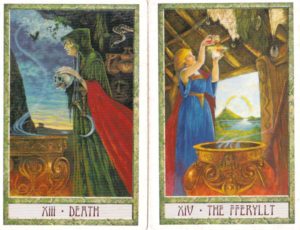 Click here to hear Philip talking about the symbolism of the cauldron in these two cards. The message of Death is ‘The old and unnecessary wants to die. What passion! The new prepares to open like a rosebud at the dawn of a new day.’ The message of The Fferyllt is ‘Allow inner and outer, masculine and feminine, to blend within you to give birth to your Creative Self.’
Click here to hear Philip talking about the symbolism of the cauldron in these two cards. The message of Death is ‘The old and unnecessary wants to die. What passion! The new prepares to open like a rosebud at the dawn of a new day.’ The message of The Fferyllt is ‘Allow inner and outer, masculine and feminine, to blend within you to give birth to your Creative Self.’
[spacer height=”20px”]LINDA: Now to The Wheel. Living as I do near sandy white beaches in Australia, the setting for this one is very familiar, but the way it depicts life’s cycles is radically different to the Rider Waite image, for example.
PHILIP: Here’s what we did with this one. ‘What’s the key, the central idea in the Wheel of Fortune?’ we asked ourselves and then translated it into DruidCraft terms. If you ask yourself ‘Who is the centre of my life? What is turning my wheel of fortune?’, the answer is you, or in the ultimate sense, Spirit: the God/dess. So, the lovely figure of the woman stooping down and casting a circle with her wand, symbolises the Goddess, the prime mover in your life – she’s casting the circle of your life.
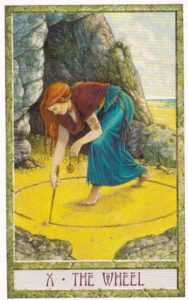 She’s holding the wonderful Druid and Wiccan wheel of the year with its eight fold cycle of ceremonies. She is at one with the cycles and in that sense symbolises your inner self and your soul because there’s a way in which you and the Goddess are one. One of the reasons we follow these spiritual ways is to take charge of our lives, not to be dependent on the vagaries of other people and their agendas. So the image shows us in charge of our lives, casting the circle of our lives. We’re not saying ‘I create my own reality and that’s that’. We accept that we’re not alone in the world and that we’re subject to greater forces and influences in the collective and outside of ourselves. So, there’s the sea in the background and the sea can always come and wash over the circle in the sand. That circle isn’t permanent because we’re going to die and the circle will be washed away.
She’s holding the wonderful Druid and Wiccan wheel of the year with its eight fold cycle of ceremonies. She is at one with the cycles and in that sense symbolises your inner self and your soul because there’s a way in which you and the Goddess are one. One of the reasons we follow these spiritual ways is to take charge of our lives, not to be dependent on the vagaries of other people and their agendas. So the image shows us in charge of our lives, casting the circle of our lives. We’re not saying ‘I create my own reality and that’s that’. We accept that we’re not alone in the world and that we’re subject to greater forces and influences in the collective and outside of ourselves. So, there’s the sea in the background and the sea can always come and wash over the circle in the sand. That circle isn’t permanent because we’re going to die and the circle will be washed away.
LINDA: And the cave behind her?
PHILIP: Yes, she’s drawing the circle in this world, the world of her incarnation, this life here. The cave symbolises the entrance to the Otherworld. There’s a simplicity in The Wheel image that Will Worthington has created, very different to the Rider Waite image with its complex symbolism.
LINDA: Next to a card that does look a lot like the Rider Waite image – the Five of Cups.
 PHILIP: Five is the number of initiation or change. You move from the stability of four and to get to the stability of six, you have to travel through the five which is unstable because it’s an uneven number. It’s the pentagram, so it’s magical as well. The question that always comes with instability is ‘how can I get the best out of this period of instability, this period of crisis?’
PHILIP: Five is the number of initiation or change. You move from the stability of four and to get to the stability of six, you have to travel through the five which is unstable because it’s an uneven number. It’s the pentagram, so it’s magical as well. The question that always comes with instability is ‘how can I get the best out of this period of instability, this period of crisis?’
To symbolise this we took the story of Taliesin and the four moments of crisis when little Gwion is transformed into a creature chased by the Goddess Ceridwen. Each moment corresponds to an element and here it’s water, the natural phase in the story of the initiate, Gwion. He’s the salmon, being chased by Ceridwen, who has turned herself into an otter and otters eat salmon, so it’s a moment of crisis and of danger. And here, the Druid or monk figure in his robe is contemplating this moment of crisis. He spilled his three cups and he just needs to contemplate this. And when he’s done contemplating he will be able to turn around and see that he’s actually got two cups full of the most wonderful elixirs to drink. In the Rider Waite image you have exactly the same symbolism but you don’t have anything going on in the river to indicate crisis.
LINDA: The deck was first published in 2004, and it’s now one of the most popular decks around. What do you think that that says about decks that come from the sort of traditions and spiritual practices we’ve just been discussing?
PHILIP: More and more people are turning to Druidry and Wicca and DruidCraft as a spiritual way. They’re returning to the old ways, like the Salmon of Wisdom. The salmon swims against the current upstream to get back to the spawning ground and I think that’s what we’re doing collectively. In order to go into the future, strangely enough, we need to turn around and go into the past – not to engage in reenactment or in nostalgia and out of fear of what the future brings. But to go back to the source of our spirituality and I think that’s what people are doing with Druidry. So, this deck works with DruidCraft and with primal images of the Old Ways, of the source of our spirituality.
Will Worthington’s nature imagery draws in the power of the land, the water and the sky and trees and plants. We feel invigorated and connected to the natural world. The other thing Will has done, which I think is just amazing, is he has created a world, hasn’t he? I mean you feel like these are windows into a world that has its own landscape, even its own furniture. I told him I’d I love it if a carpenter could make some of his chairs. He does a good line in chairs, doesn’t he?
LINDA: Great oaks from little acorns grow. Sorry I couldn’t resist that…you’ve seen the Order flourish, you’ve created two Oracle decks as well as The DruidCraft Tarot which has now truly entered the modern era with the release of an app. Have you been surprised by the growth of the little seeds you planted over the years?
PHILIP: Absolutely surprised! And I readily admit to being totally non-clairvoyant when it comes to technological developments. I resist and am completely blind to their potential. When my son first set up email for me, I said, ‘I’m sure I’ll never use it, but go ahead if you want to’. When somebody suggested a podcast for the Order, I was completely ignorant, didn’t know what a podcast was and said, ‘OK, but I’m sure no one will listen’. Now we have 20,000 people a month listening to it. And the same thing with the app. When a company in the States offered to make an app I thought it was an awful idea, but luckily, I said, ‘Okay, let’s see how it goes’. And they produced something which I find absolutely extraordinary. It records your readings, a little voice talks to you – it can be turned off, of course. There’s a whole bunch of spreads, you can choose different spread backgrounds, you can even shuffle and it’s got the entire book!
 About Philip Carr-Gomm
About Philip Carr-Gomm
Philip has a degree in psychology from University College London, and trained in psychotherapy for adults at The Institute of Psychosynthesis, and in play therapy for children with Dr Rachel Pinney. He also trained in Montessori education and founded the Lewes Montessori School. When a teenager Philip studied with his teacher, the Chief Druid Ross Nichols, and in 1988 he was asked to lead The Order of Bards Ovates and Druids. He has written over a dozen books on spirituality and gives talks and workshops all over the world.
‘Although my spiritual practice is rooted in Druidry,’ he says, ‘I believe we have entered an era in which we can move beyond attachments to labels, drawing instead upon the Perennial Tradition, being inspired by the wisdom in all spiritual paths and teachings – following the Way of the Universal Mystic. I am also particularly interested in ways in which we can preserve and protect the natural world for future generations.’ Click here to visit Philip’s website.
Over to you!
Do you use The DruidCraft Tarot for readings? If so, how do clients respond to the imagery? If you’re unfamiliar with the deck, has the discussion about some of the cards sparked your interest? If so, why? We’d love to hear from you!


